ignition PONTIAC FIREBIRD 1998 Owner's Manual
[x] Cancel search | Manufacturer: PONTIAC, Model Year: 1998, Model line: FIREBIRD, Model: PONTIAC FIREBIRD 1998Pages: 406, PDF Size: 18.23 MB
Page 82 of 406
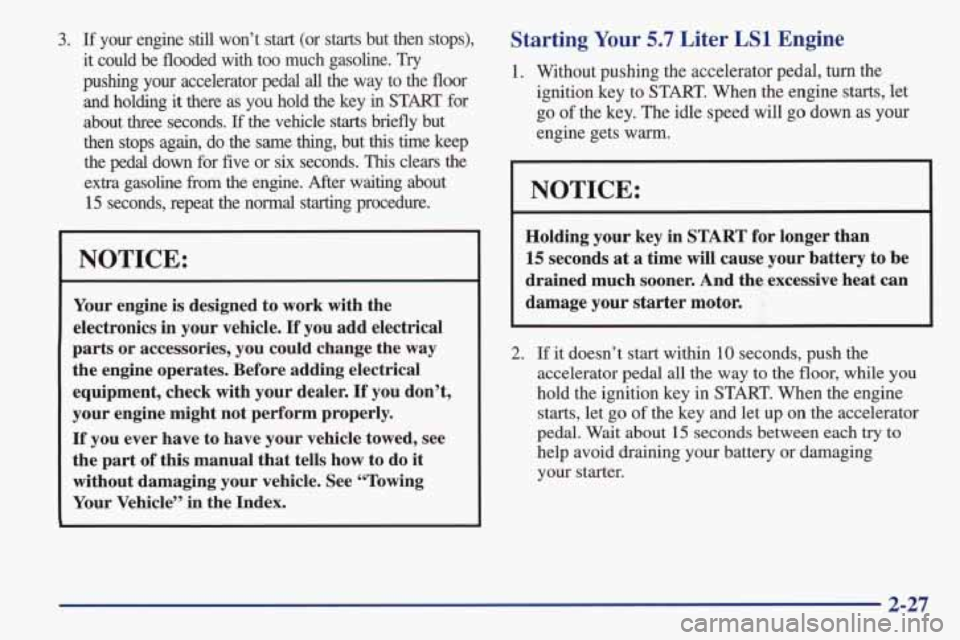
3. If your enpe still won’t start (or starts but then stops),
it could be flooded with too much gasoline. Try
pushing your accelerator pedal
all the way to the floor
and holding it there as you hold the key in START for
about three seconds. If the vehicle
starts briefly but
then stops again, do the same
thing, but this time keep
the pedal down for five
or six seconds. This clears the
extra gasoline
from the engine. After waiting about
15 seconds, repeat the normal starting procedure.
NOTICE:
Your engine is designed to work with the
electronics in your vehicle.
If you add electrical
parts or accessories, you could change the way
the engine operates. Before adding electrical
1 equipment, check with your dealer. If you don’t,
your engine might not perform properly.
If you ever have to have your vehicle towed, see
the part
of this manual that tells how to do it
without damaging your vehicle. See “Towing
~ Your Vehicle” in the Index.
Starting Your 5.7 Liter LS1 Engine
1. Without pushing the accelerator pedal, turn the
ignition key to START. When the engine starts, let
go of the key. The idle speed will go down as your
engine gets warm.
I
NOTICE:
Holding your key in START for longer than
15 seconds at a time will cause your battery to be
drained much sooner. And the excessive heat can
damage your starter motor.
2. If it doesn’t start within 10 seconds, push the
accelerator pedal all the way to the
floor, while you
hold the ignition key in START. When the engine starts, let
go of the key and let up on the accelerator
pedal. Wait about
15 seconds between each try to
help avoid draining your battery
or damaging
your starter.
2-27
Page 83 of 406
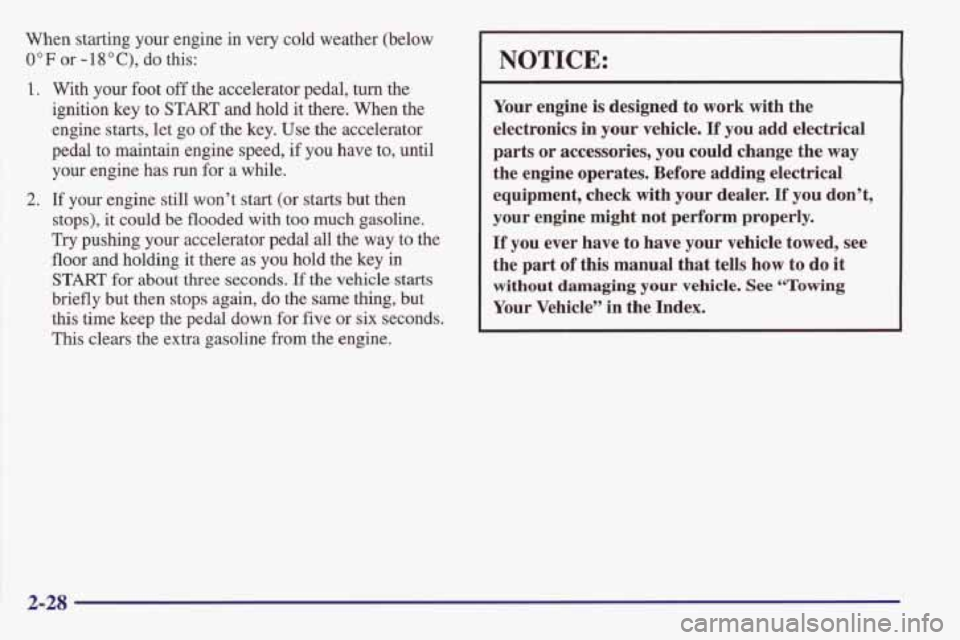
When starting your engine in very cold weather (below
0°F or -18”C), do this:
1. With your foot off the accelerator pedal, turn the
ignition key to
START and hold it there. When the
engine starts, let
go of the key. Use the accelerator
pedal to maintain engine speed, if you have to, until your engine has run
for a while.
2. If your engine still won’t start (or starts but then
stops), it could be flooded with
too much gasoline.
Try pushing your accelerator pedal all the way to the
floor and holding it there as you hold the key in
START for about three seconds. If the vehicle starts
briefly but then stops again, do the same thing, but
this time keep the pedal down for five or six seconds.
This clears the extra gasoline from the engine.
NOTICE:
Your engine is designed to work with the
electronics in your vehicle.
If you add electrical
parts or accessories, you could change the way
the engine operates. Before adding electrical
equipment, check
with your dealer. If you don’t,
your engine might not perform properly.
If you ever have to have your vehicle towed, see
the part
of this manual that tells how to do it
without damaging your vehicle. See “Towing
Your Vehicle” in the Index.
2-28
Page 86 of 406
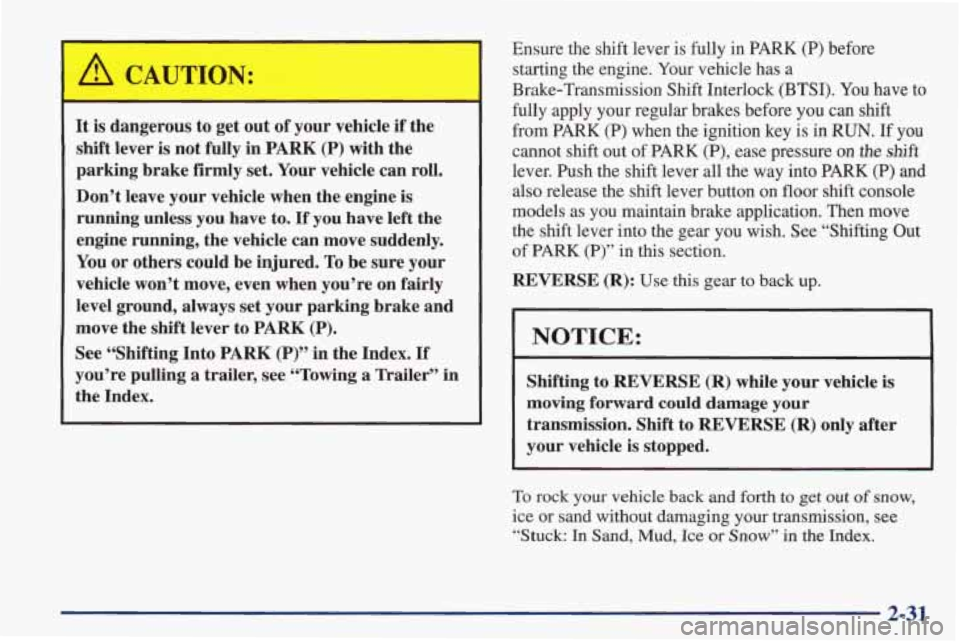
A CAUTION:
It is dangerous to get out of your vehicle if the
shift lever is not fully in PARK (P) with the
parking brake firmly set. Your vehicle can roll.
Don’t leave your vehicle when the engine is
running unless you have to.
If you have left the
engine running, the vehicle can move suddenly.
You
or others could be injured. To be sure your
vehicle won’t move, even when you’re on fairly
level ground, always set your parking brake and
move the shift lever to PARK
(P).
See “Shifting Into PARK (P)” in the Index. If
you’re pulling a trailer, see “Towing a Trailer” in
the Index. Ensure the
shift lever is fully
in PARK (P) before
starting the engine. Your vehicle has a
Brake-Transmission Shift Interlock
(BTSI). You have to
fully apply your regular brakes before you can shift
from PARK (P) when the ignition key is in RUN. If you
cannot shift out of PARK (P), ease pressure on the shift
lever. Push the shift lever all the way into PARK (P) and
also release the shift lever button on floor shift console
models as
you maintain brake application. Then move
the shift lever into the gear you wish. See “Shifting Out
of PARK (P)” in this section.
REVERSE (R): Use
this gear to back up.
I NOTICE:
Shifting to REVERSE (R) while your vehicle is
moving forward could damage your
transmission. Shift to REVERSE
(R) only after
your vehicle
is stopped.
To rock your vehicle back and forth to get out of snow,
ice or sand without damaging your transmission, see
“Stuck:
In Sand, Mud, Ice or Snow” in the Index.
2-31
Page 91 of 406

6-Speed
This is your shift pattern.
FIRST (1): Press the clutch pedal and shift into
FIRST
(1). Then slowly let up on the clutch pedal as
you press the accelerator pedal.
You can shift into FIRST
(1) when you’re going less
than
20 mph (32 km/h). If you’ve come to a complete
stop and it’s hard to shift into FIRST (l), put the shift
lever in
NEUTRAL (N) and let up on the clutch. Press
the clutch pedal down. Then shift into FIRST
(1).
SECOND (2): Press the clutch pedal as you let up on
the accelerator pedal and shift into SECOND (2). Then,
slowly
let up on the clutch pedal as you press the
accelerator pedal.
THIRD(3),FOURTH(4),FIFTH(5)and
SIXTH (6): Shift into THIRD (3), FOURTH (4),
FIFTH (5) and SIXTH (6) gear the same way you do for
SECOND (2). Slowly let up on the clutch pedal as you
press the accelerator pedal.
To stop, let up on the accelerator pedal and press the
brake pedal. Just before the vehicle stops, press
the clutch pedal and brake pedal, and shift to
NEUTRAL
(N).
NEUTRAL (N): Use this position when you start or
idle your engine.
REVERSE (R): To back up, press the clutch pedal and
shift
into REVERSE (R). Let up on the clutch pedal
slowly while pressing the accelerator pedal. If you shift
from SIXTH
(6), into REVERSE (R), the shift lever
must be first placed in NEUTRAL
(N) position centered
between SECOND
(2) and THIRD (3) prior to shifting
into REVERSE (R).
Your six-speed manual transmission has a feature that
allows
you to safely shift into REVERSE (R) while the
vehicle is rolling (at less than
5 mph (8 km/h)).
If you have turned your ignition off and want to park your
vehicle
in REVERSE (R), you will have to move the shift
lever quickly to the right, then forward into gear.
2-36
Page 94 of 406
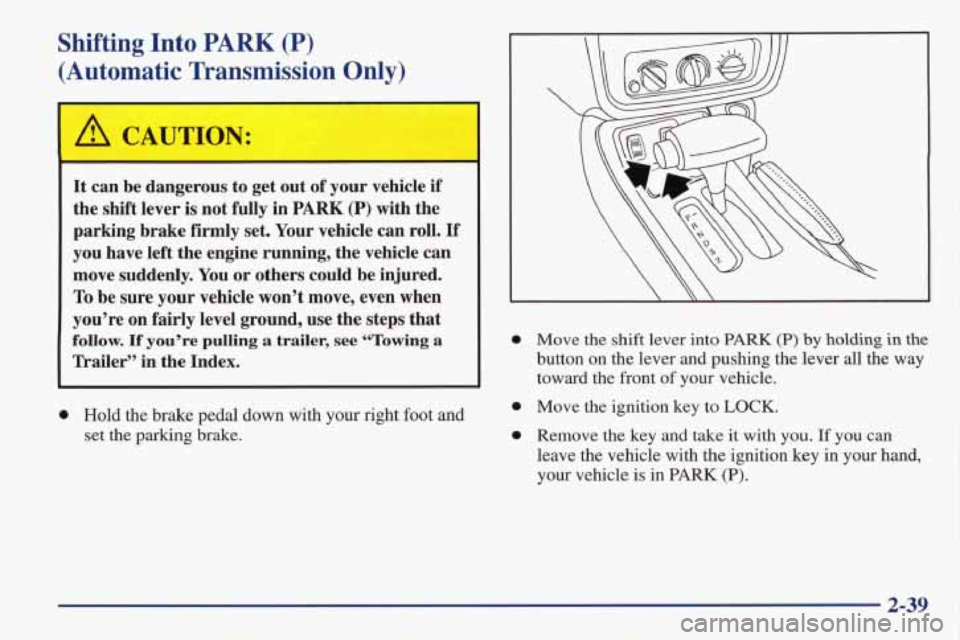
Shifting Into PARK (P)
:Automatic Transmission Only)
A CAUTION:
It can be dangerous to get out of your vehicle if
the shift lever is not fully in
PARK (P) with the
parking brake firmly set. Your vehicle can roll.
If
you have left the engine running, the vehicle can
move suddenly. You or others could be injured.
To be sure your vehicle won’t move, even when
you’re on fairly level ground, use the steps that
follow. If you’re pulling a trailer, see “Towing a
Trailer” in the Index.
0 Hold the brake pedal down with your right foot and
set the
parking brake.
0 Move the shift lever into PARK (P) by holding in the
button on the lever and pushing the lever all the way
toward the front of your vehicle.
0 Move the ignition key to LOCK.
0 Remove the key and take it with you. If you can
leave the vehicle with the ignition key in your hand,
your vehicle
is in PARK (P).
2-39
Page 96 of 406
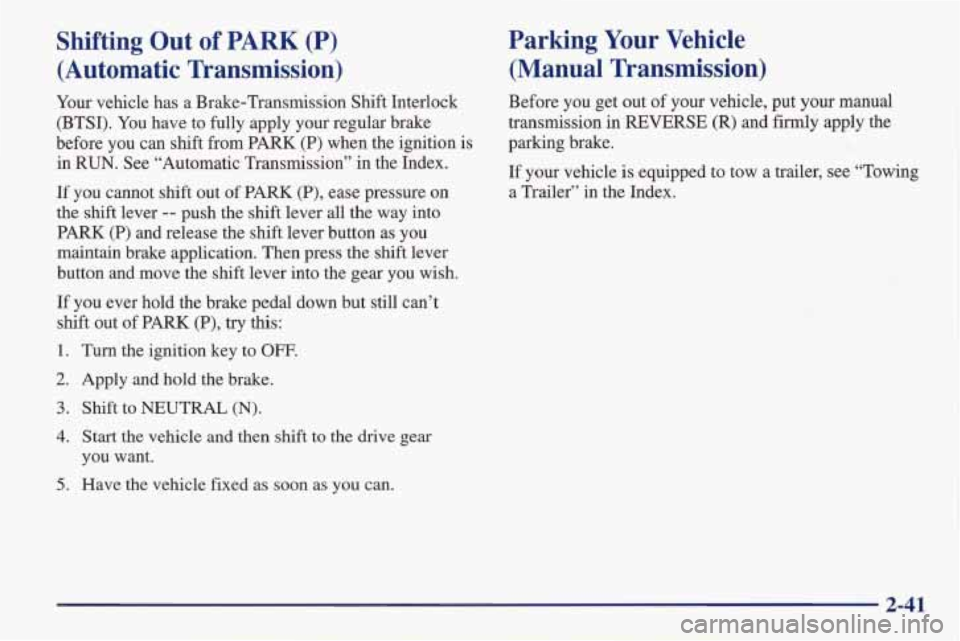
Shifting Out of PARK (P)
(Automatic Transmission) Parking Your Vehicle
(Manual Transmission)
Your
vehicle has a Brake-Transmission Shift Interlock Before you get out of your vehicle, put your manual
(BTSI). You have to fully apply your regular brake transmission in REVERSE \
(R) and firmly apply the
before you can shift from PARK (P) when the ignition is parking brake.
in RUN. See “Automatic Transmission” in the Index.
If
you cannot shift out of PARK (P), ease pressure on a Trailer” in the Index.
the shift lever
-- push the shift lever all the way into
PARK
(P) and release the shift lever button as you
maintain brake application. Then press the shift lever
button and move the shift lever into the gear you wish. If
your vehicle
is equipped to tow a trailer, see “Towing
If you ever hold the brake pedal down but still can’t
shift out of PARK (P), try this:
1. Turn the ignition key to OFF.
2. Apply and hold the brake.
3. Shift to NEUTRAL (N).
4. Start the vehicle and then shift to the drive gear
you want.
5. Have the vehicle fixed as soon as you can.
2-41
Page 99 of 406

Limited-Slip Rear Axle
If you have this feature, your limited-slip rear axle can
give you additional traction on snow, mud, ice,
sand or
gravel. It works like a standard axle most
of the time,
but when one of the rear wheels has
no traction and the
other does,
this feature will allow the wheel with
traction to move the vehicle.
Parking Brake
To release the parking brake, hold the brake pedal down.
Pull the parking brake lever up until you can push in the
release button. Hold the release button
in as you move
the brake lever all the way
down.
To set the parking brake, hold the brake pedal down and
pull up on the parking brake lever. If the ignition is on,
the brake system warning light
will come on.
NOTICE: I
~~ ~
Driving with the parking brake on can cause
your rear brakes to overheat.
You may have to
replace them, and
you could also damage other
parts
of your vehicle.
2-44
Page 100 of 406
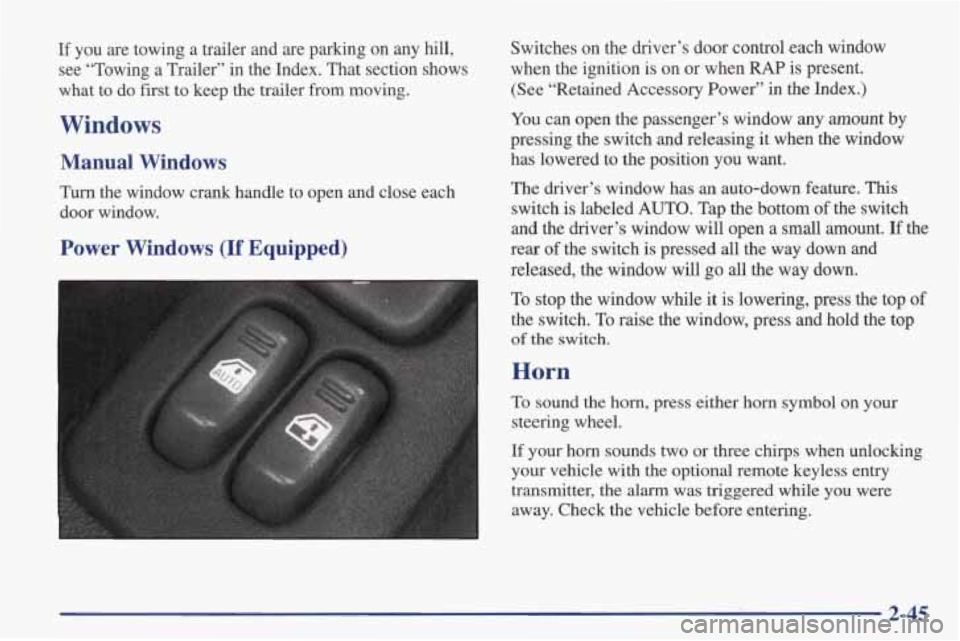
If you are towing a trailer and are parking on any hill,
see “Towing a Trailer” in the Index. That section shows
what to do first to keep the trailer from moving.
Windows
Manual Windows
Turn the window crank handle to open and close each
door window.
Power Windows (If Equipped)
Switches on the driver’s door control each window
when the ignition is on or when
RAP is present.
(See “Retained Accessory Power” in the Index.)
You can open the passenger’s window any amount by
pressing the switch and releasing it when the window
has lowered to the position you want.
The driver’s window has an auto-down feature. This
switch is labeled AUTO. Tap the bottom of the switch
and the driver’s window will open a small amount.
If the
rear of the switch is pressed all the way down and
released, the window will
go all the way down.
To stop the window while
it is lowering, press the top of
the switch.
To raise the window, press and hold the top
of the switch.
Horn
To sound the horn, press either horn symbol on your
steering wheel.
If your horn sounds two or three chirps when unlocking
your vehicle
with the optional remote keyless entry
transmitter, the
alarm was triggered while you were
away. Check the vehicle before entering.
2-45
Page 107 of 406

Ending Out of Cruise Control
There are several ways to turn off the cruise control:
Step lightly on the brake pedal or push the clutch
pedal, if you have a manual transmission; or
Move the cruise switch to OFF.
Erasing Speed Memory
When you turn off the cruise control or the ignition,
your cruise control
set speed memory is erased.
Exterior Lamps
-.
The main lamp control is a knob that works these lamps:
Headlamps
Taillamps
Parking Lamps
License Lamps
0 Sidemarker Lamps
0 Instrument Panel Lights
# , This setting turns on your headlamps and other
operating lamps.
pg This setting turns on your parking lamps and other
operating lamps without your headlamps.
Turn the
knob to OFF to turn off the lamps.
-‘a-
Headlamps On Reminder
If you turn the ignition off and leave the lamps on, you
will hear
a chime lasting up to five seconds. If the lamps
are still on when
you open the driver’s door, the chime
will sound
again.
2-52
Page 108 of 406

Headlamp Doors Daytime Running Lamps
The headlamp doors are designed to open when you turn
the headlamps
on and close when
you turn the
headlamps off. The headlamp doors can
be opened
without turning on the headlamps by turning the
headlamps on, then turning the switch back to the
parking lamps position.
The headlamp doors should
be open when driving in
icy or snowy conditions to prevent the doors from
freezing closed, and when washing the vehicle to help
clean the headlamps.
You can open the headlamp doors manually:
1. Open the hood.
2. Remove the plastic cover from the retractor
motor knob.
3. Turn the retractor motor knob counterclockwise until
the headlamp door
is fully open. The knob will get
harder to turn when the headlamp door
is all the
way up.
4. Replace the plastic cover on the retractor motor knob. Daytime Running Lamps (DRL) can make
it easier for
others to
see the front of your vehicle during the day.
DRL can be helpful in many different driving
conditions, but they can be especially helpful in the
short periods after dawn and before sunset.
For Canadian vehicles, a light sensor on top of the
instrument panel automatically turns the headlamps on,
so be sure it isn’t covered.
The DRL system will make your front turn signal lamps
come on when:
0 The ignition is on,
the headlamp switch is OFF,
0 the parking brake is released and
0 it is bright enough outside (on Canadian vehicles).
To manually close the headlamp doors, turn the lamps
off and turn the retractor motor knob clockwise. If the
headlamp doors aren’t working properly, see your dealer
for help.
2-53